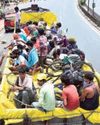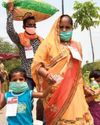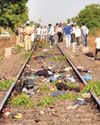The anger and violence in Kashmir following the killing of the Hizbul Mujahideen leader Burhan Wani defines the heightened anti-India sentiment in the valley.

THE BODY OF Burhan Wani, the Hizbul Mujahideen commander who was killed in an encounter in the Kokarnag area of Anantnag district, at his home in Tral, south of Srinagar, on July 9.
PEACE in the Kashmir Valley has always been deceptive. Its fragility has been the reality on the ground but no lessons have been learnt. Kashmir has been witnessing a different phase of resistance in the past eight years, which even its leaders have been unable to curb. The current trouble, which began with thekilling of 21-year-old Burhan Wani, the most wanted commander of the Hizbul Mujahideen, has brought to the fore a new layer of reality in the valley’s unending conflict. It is a hard and rather disturbing layer in the sense that Kashmiris now hark back to the 1990s when they eulogised the militants.
The fresh cycle of violence has left 35 dead and 1,500 people injured. The injured, who are undergoing treatment in various hospitals, may not even be able to lead normal lives any more. Scores of young boys who have been hit by pellets may lose their eyesight. The valley has been placed on extended lockdown with curfew restrictions, although people have successfully defied the curfew at many places. The anger against the state has touched a new high and Chief Minister Mehbooba Mufti has failed to douse the flames.
Denne historien er fra August 5, 2016-utgaven av FRONTLINE.
Start din 7-dagers gratis prøveperiode på Magzter GOLD for å få tilgang til tusenvis av utvalgte premiumhistorier og 9000+ magasiner og aviser.
Allerede abonnent ? Logg på
Denne historien er fra August 5, 2016-utgaven av FRONTLINE.
Start din 7-dagers gratis prøveperiode på Magzter GOLD for å få tilgang til tusenvis av utvalgte premiumhistorier og 9000+ magasiner og aviser.
Allerede abonnent? Logg på

How Not To Handle An Epidemic
The lockdowns were meant to buy time to put in place appropriate health measures and contain the coronavirus’ spread, but they have failed to achieve the objective and heaped immense misery on the marginalised sections of society. India is still in the exponential phase of the COVID-19 infection and community transmission is a reality that the government refuses to accept.

Tragedy on foot
As the COVID-19-induced lockdown cuts the ground beneath their feet in Tamil Nadu, thousands of migrant workers are trudging along the highway to the relative safety of their upcountry homes.

Sarpanchs as game changers
Odisha manages to keep COVID-19 well under control because of the strong participation of panchayati raj institutions and the community at the grass-roots level under the leadership of Chief Minister Naveen Patnaik.

Scapegoating China
As the COVID-19 death rate spikes and the economy tanks in the United States, Donald Trump and his advisers target China and the World Health Organisation with an eye to winning the forthcoming presidential election.

New worries
Kerala’s measured approach to the pandemic and lockdown has yielded results. But it still has to grapple with their huge economic impact on its economy, which it feels the Centre’s special financial relief package does little to alleviate.
No love lost for labour
Taking advantage of the lockdown and the inability of workers to organise protests, many State governments introduce sweeping changes to labour laws to the detriment of workers on the pretext of reviving production and boosting the economy.

Capital's Malthusian moment
In a world that needs substantial reorienting of production and distribution, Indian capital is resorting to a militant form of moribund neoliberalism to overcome its current crisis. In this pursuit of profit, it is ready and willing to throw into mortal peril millions whom it adjudicates as not worth their means—an admixture of social Darwinism born of capital’s avarice and brutalism spawned by Hindutva. .

Understanding migration
When governments and their plans are found to be blatantly wanting in addressing reverse migration, exercises such as the Ekta Parishad’s survey of migrant workers throughout India can be useful to work out creative long-lasting solutions.

Waiting for Jabalpur moment
The Supreme Court’s role in ensuring executive accountability during the ongoing lockdown leaves much to be desired. Standing in shining contrast is the record of some High Courts.

An empty package
The Modi regime, which has been unable to control the COVID-19 infection, restore economic activity and provide relief to millions exposed to starvation, trains its sights on Indian democracy, making use of the panic generated by fear and a lockdown that forecloses paths of resistance.